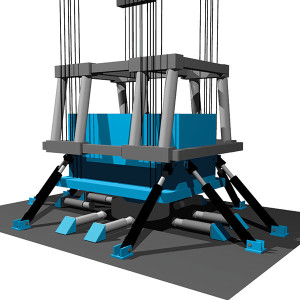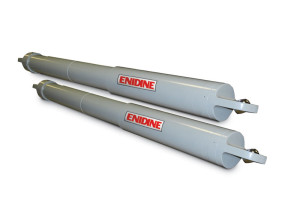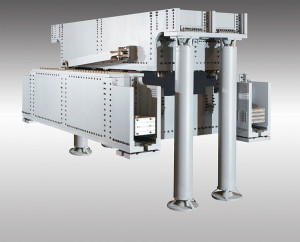Tuned Mass Damper Systems Deliver
In developed cities around the world, space on the ground is becoming scarce. The new trend is to build slender, “mega-tall” skyscrapers. These structures require special considerations to mitigate the effects of wind forces that develop against the building’s façade. Wind forces can cause significant sway or twist, particularly in the upper floors of the skyscraper, and wind-induced accelerations can cause motion sickness for many individuals inside these structures.
Tuned Mass Damper (TMD) systems have gained popularity in recent years as a cost-effective solution to mitigate wind-induced vibrations in slender, mega-tall structures. A TMD is a system that is tuned to the building’s natural frequency and acts 90 degrees out-of-phase with external forces to add damping, dissipate dynamic energy, and ultimately reduce accelerations to imperceptible levels to maintain occupant comfort of the structures. Traditionally, these mega-tall structures have been designed with conventional structural materials and stiff components within the lateral load-resisting system to overcome the accelerations due to external wind forces. However, when using a design philosophy that begins with the intent to incorporate a TMD system, engineers can design the structural system with lighter-weight, more flexible components, which can translate into significant cost savings even once the cost of the TMD system is included.
One common TMD often considered for mega-tall skyscrapers is the pendulum system. There are many different ways to configure such a system to control structural accelerations. The pendulum system itself is a large mass, usually a cube of steel weighing several hundred to one thousand tons, hung by cables through a central shaft or room within the structure.
Why are TMD Systems Ideal for Wind Mitigation?
Based on many years of data, we can reasonably predict the severity and incidence of wind events that act upon a building in a particular location and using engineering analysis we can estimate a building’s natural frequency. TMD systems could theoretically be used to mitigate demands due to other lateral forces such as from seismic excitations; however, ground motion excites a structure at multiple frequencies and therefore a TMD system is not as effective to counter earthquake motion. If there was an earthquake near a skyscraper, a TMD system might provide some protection, but it would only mitigate the effects of excitations near the tuned frequency. Thus, when looking to mitigate the effects of wind forces on a structure with one natural frequency, TMD systems are an ideal solution.
However, a building’s frequency can change over time, resulting in a need to service TMDs periodically. Although the structure of a building and external wind forces typically remain the same, certain floors may be used for purposes other than their original design. For example, if a room was originally dedicated for a gymnasium, but is being converted to accommodate a swimming pool, a significant amount of weight is added to that floor. The additional weight can, in turn, change the building’s natural frequency. So the ability to adjust the tuning of a mass damper system over time is essential to keeping it matched with the building’s frequency.
The Benefits of FVDs in TMD Systems
TMD systems may incorporate several proprietary damping technologies, and fluid viscous dampers (FVDs) can be used in combination with the pendulum system to provide easier, safer and more cost-effective servicing and tuning of the TMD. FVDs add damping to a structure and therefore reduce the structural response caused by external wind forces.
FVDs are passive energy dissipation devices that convert kinetic energy into heat, typically over multiple cycles of deformation. The basic relationship governing the behavior and performance of a fluid viscous damping device is defined by the Constitutive Law:
Constitutive Law – “A relation between two physical quantities (especially kinetic quantities as related to kinematic quantities) that is specific to a material or substance, and approximates the response of that material to external stimuli, usually as applied fields or forces.”
- F: Damping Force [kN]
- V: Relative Structural Velocity [m/sec]
- C: Damping Coefficient [kN/(m/sec)α]
- α: Velocity Exponent
F = CV α
A resultant force produced by an FVD is related to a power function of the velocity (non-linear FVD), where a Velocity Exponent of 1 results in a force that is proportional to the relative structural velocity (linear FVD). FVDs use silicone fluid and custom orifice geometry to obtain linear or non-linear FVD performance. Velocity exponents of 0.1 to 2.0 are possible.
FVDs are attached to the structural system on one end, and the pendulum mass damper on the opposite end, an ideal location for FVDs to enhance system damping due to the large differential displacements cause by building deformations being out-of-phase with pendulum displacements. The function of the FVD is to dissipate wind energy, via kinetic friction, by creating heat energy which is easily managed by the building’s HVAC system. Kinetic friction is produced from the hydraulics within the piston by the actuation of a piston rod pushing internal hydraulic fluid through engineered orifices. The resultant resistance produced by this actuation through the damper stroke is the damping performance.
It is important to note that a skyscraper with a mass damper system will still deflect up to a few feet at the top, where the accelerations are the highest. The primary purpose of the TMD system is too slow down the building’s acceleration, so it is imperceptible to the human occupants inside the building, preventing motion sickness. Unfortunately, where a TMD system is needed – at the highest points of the structure – is also some of the most valuable real-estate in developed cities like New York City.

Design of TMD systems using ITT Enidine fluid viscous damper technology increases occupant comfort, reduces life cycle costs, and increases safety.
While the primary purpose of the FVD is to dissipate energy, new design features are being incorporated into these devices that may allow easier maintenance and tuning, which can ultimately help reduce the lifecycle cost of the TMD system. A traditional TMD system is mechanical and, to stop the pendulum swinging motion, an engineer has to attach a steel clamp to the large, moving mass to slow and stop the swing. This can be dangerous to the operator because of the potential to become entrapped or pinched between the moving TMD mass and other components of the TMD system. FVDs can include a “lock-out” that allows the damper movement to be stopped and locked from outside the range of travel of the TMD mass for safe servicing and inspection of the TMD system. FVDs can also include the ability to “tune” the damping performance, which can allow for simple routine tuning of the TMD system to ensure it is always operating as designed. These specialty FVD features are as simple as turning a knob. These features are critical because of the inevitable need for the TMD system to be “locked-out” and “tuned” for the continued safety and comfort of individuals inside these structures.
Conclusion
It is important to match the TMD and FVD design to the application requirement and to work with the right manufacturer, designer, and engineer to provide the ideal system for the structure. There are many benefits of incorporating a tuned mass damper system to mitigate the effects of wind on infrastructure, specifically skyscrapers. Fluid viscous dampers are the solution to improve a TMD system’s performance further and improve the long-term safety and quality of a structure.▪


